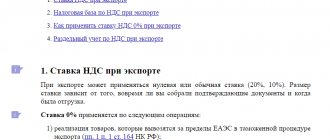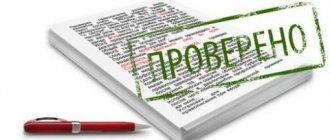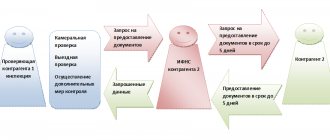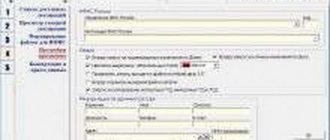The construction of capital construction projects for use for production purposes can be carried out using the enterprise’s own funds and capabilities or involving contractors. In this case, all work, from the formation of the project and estimate to the final cycle - turnkey delivery - is carried out by highly specialized specialists - professionals. But in any situation, this event lies in the sphere of state interests.
The construction of facilities is the basis for taxation, one of the main state taxes that fill the budget. Actually we will talk about value added tax and filling out the corresponding declaration. And today we will consider the refund (deduction) of VAT during the construction of residential buildings, fixed assets by contract, as well as the deduction of VAT from the developer during shared construction and other cases of compensation.
Find out how to solve your specific problem. Submit your question using the form (below) and one of our lawyers will call you back to provide a free consultation.
In what cases is VAT paid on the simplified tax system?
The simplified tax system exempts you from paying VAT. But the Tax Code of the Russian Federation provides for several situations when payers of the simplified tax system keep VAT records:
- Execution of construction contracts with companies on OSNO - it is necessary to take into account and compensate for the costs of VAT, which is paid as part of the cost of materials, fuels and lubricants, and consumable tools.
- Import of foreign goods into the Russian Federation for trade - VAT must be charged on the transaction amount and customs duties paid and then transferred to the budget upon sale (clause 3 of Article 346.11 of the Tax Code of the Russian Federation).
- Execution of trust management agreements, simple and investment partnerships, if one of the participants on the simplified tax system, and the second on the OSNO - simplified one, keeps records and pays VAT on all transactions within the framework of the agreement (Article 174.1 of the Tax Code of the Russian Federation).
- Rent or purchase of municipal property into the ownership of a simplified person - VAT should be allocated from the transaction amount, paid to the budget and submitted as a tax agent declaration (clause 3 of Article 161 of the Tax Code of the Russian Federation).
- Issuance by the supplier of an invoice on the simplified tax system indicating the amount of VAT at the request of the buyer - it is necessary to pay the tax and submit reports (clause 5 of article 173 of the Tax Code of the Russian Federation).
In the article we will consider the first situation, since in a construction contract, with the help of VAT compensation, tax risks can be legally minimized.
UTII
Organizations that pay UTII are required to keep accounting records in full (Article 2, 5 of the Law of December 6, 2011 No. 402-FZ). Therefore, when reflecting fixed assets built by contract in accounting, apply the same rules as under the general taxation system.
Operations related to the receipt, movement and disposal of fixed assets do not affect the calculation of UTII (clause 1 of Article 346.29 of the Tax Code of the Russian Federation).
If a fixed asset created by contract is a piece of real estate, then the organization must register the ownership of it (Part 1, Article 4 of Law No. 122-FZ of July 21, 1997).
Why and when is VAT compensation calculated?
VAT compensation is a tax instrument that gives simplified taxation tax payers the opportunity to work with customers on OSNO. Compensation allows you to take into account and deduct VAT paid by simplifiers when purchasing raw materials, materials, fuels and lubricants used in construction work. The amounts of such VAT form the contractor’s costs, which must be covered by the contract price (Article 709 of the Civil Code of the Russian Federation).
Check with your counterparties for free to receive a full VAT refund
When a contractor using the simplified tax system performs work for the customer using OSNO, both are at risk in the event of errors in accounting. The customer - in that the tax paid to the contractor will not be included in the VAT deduction. The contractor runs the risk that the tax authorities will recognize the tax amount as unjust enrichment and reduce the contract price by the tax amount. To prevent this from happening, it is important to correctly prepare all primary and accounting documents from the very beginning.
The general scheme of interaction between the parties to a construction contract looks like this:
- Determining the scope of work and preliminary drawing up an estimate.
- Coordination of all conditions and conclusion of the contract.
- Execution of work.
- Acceptance of work and final payment.
The estimate is the primary document that is drawn up at the first stage of interaction when carrying out construction or other contract work. It describes the stages and order of work and fully takes into account all the contractor’s costs. All subsequent documents (invoices, acts, KS-2, KS-3 and others) are drawn up only on the basis of the approved estimate.
Procedure for receiving a refund in 2019
Required documents
In order to carry out the VAT deduction procedure, it is necessary to submit to the local tax authority an application of the established form and a package of necessary documents confirming the right to deduction. A standard application form can be found on the website of the Federal Federal Service of the Russian Federation or at the local tax authority.
The legally approved grounds for claiming VAT deduction are:
- When construction is carried out by a contractor - form KS-2, which confirms the fulfillment of contractual obligations for development, completed individual installation, commissioning and other work inextricably linked with the facility.
- When constructing using an economic method or a mixed method, in order to deduct VAT, you will need invoices, delivery notes and accompanying shipping documentation, bank statements with attachments in the form of payment orders for payment for materials and work, a selection of acts of work performed and estimates for services consumed.
- Financial documents confirming payment of input VAT when goods cross the border of the Russian Federation.
Construction and its taxation is one of the most complex and time-consuming accounting tasks. Therefore, if you have insufficient experience, it is better for a novice accountant to resort to the services of specialized firms and bureaus.
Procedure
- You should independently collect all original documents confirming the costs of constructing the facility.
- Make copies of them and certify them with the company seal and the signature of the manager.
- Fill out a standard application in typewritten or computer format.
- Attach copies of personal documents of the responsible person, as well as the head of the company and the financial service.
- Submit the application package to the regional fiscal service office and obtain a specialist’s signature.
- Within the period established by law, obtain a Resolution on permission to deduct VAT.
Today, it is stipulated that submitting documents is possible in several ways. First of all, the most conservative method is to come to the local FS in person. It is more convenient and reliable to send by valuable postal parcel with a list of attachments and electronically to the tax service website. The latter option allows you to speed up the process and save a lot of working time.
If documents are submitted by an authorized person, then a special mark on the application is required, as well as copies of his passport, Taxpayer Identification Number, notarized power of attorney or order from the head of the principal company. You can even check your VAT accrual online to avoid fines and penalties. It’s also worth knowing how to get a VAT refund if you overpay.
This video will tell you about the agreement of shared participation in construction and VAT reimbursement:
Accounting for VAT costs under the simplified tax system
Local estimates must be drawn up according to the rules given in section 4 of the Resolution of the State Construction Committee of Russia dated March 5, 2004 No. 15/1. All construction costs are formed into groups: types of work, resources, equipment operation and others. The cost includes direct costs, overheads, and estimated profit, shown excluding taxes.
In construction work, the contractor’s usual costs are the costs of construction materials, the purchase of fuels and lubricants for equipment, and the costs of repairing mechanisms carried out by third-party organizations. When purchasing materials or services to perform work, the simplifier pays VAT as part of their price, but in the estimate for the customer he must indicate their cost without VAT.
For example, a construction company entered into a contract and purchased materials for 120 thousand rubles, including VAT at a rate of 20% - 20 thousand rubles. In practice, three cost accounting options are used, but only one is correct. The second option will not allow the customer to take into account the amount of VAT as part of expenses. And in the third case, the contractor will be obliged to transfer the tax amount to the budget in full and report as a tax agent.
| Right | Wrong |
| Option 1 In the estimate, in the “Cost” column, enter the amount without tax. In the “Limits, Costs” section of the “Taxes and Mandatory Payments” chapter, add the column “Costs for VAT compensation under the simplified tax system” and indicate in it the amount of tax paid 20 thousand rubles | Option 2 Include in the estimate the cost of materials without tax in the amount of 100 thousand rubles, and take into account the tax amount of 20 thousand rubles as part of the expenses for the simplified tax system Option 3 Prepare an estimate for the customer, including VAT, for the entire amount of costs. To receive payment upon completion of work, issue an invoice and highlight VAT on it |
In the example, the calculation of compensation is given schematically. In fact, everything is more complicated: compensation is calculated according to a special formula.
Normative base
The procedure for reflecting VAT during the construction of fixed assets, as well as the mechanism for obtaining a tax deduction, is regulated by the following legislative acts:
| No. | Normative act | Description |
| 1 | PBU 6/01 | When reflecting operations for the construction of fixed assets (on your own, through contractors, in a mixed way), you should be guided by the general rules of accounting, in particular, the provisions provided for in PBU 6/01 “Accounting for fixed assets.” |
| 2 | NK chapter 21 | The regulatory document describes the general procedure for recording VAT (taxpayers, taxable transactions under fixed assets, exemptions from payment, etc.). |
| 3 | NK Art. 171 | The Tax Code describes the procedure for using the right to a tax deduction during the construction of an operating system. |
| 4 | NK clause 10 art. 167 | According to this provision of the Tax Code, the company’s obligations to pay VAT to the budget arise at the moment the completed asset is accepted onto its balance sheet. |
| 5 | Government Decree No. 914 of 02.12.2000 | The document describes the mechanism for issuing invoices during the construction of operating systems, as well as the specifics of reflecting documents in the Sales Book. |
| 6 | Explanations in letters from ministries and departments | Special cases and controversial situations regarding VAT accounting during the construction of fixed assets are discussed in letters from various departments. In particular: · letter of the Ministry of Finance No. ШТ-6-03/527 dated 07/04/2007 describes the procedure for determining the tax base for a mixed type of OS construction (the company’s own forces + contractors); · the letter of the Ministry of Finance No. 04-03-11/91 dated November 5, 2003 indicates the occurrence of tax obligations for a company that carries out construction and installation work on its own (if such work is not capital). |
Formula for calculating VAT compensation costs for simplified people
To calculate VAT compensation under the simplified tax system, you must use a single formula:
(MAT + (EM - ZPM) + HP × 0.1712 + SP × 0.15 + OB) × 0.20,
Where:
- MAT - materials from the estimate;
- (EM - ZPM) - the total cost of operating machines (fuels and lubricants, repairs, rental payments, etc.) minus the wages of drivers;
- HP - the share of overhead costs in the composition of material costs (the standard for including overhead costs in VAT compensation is 17.12%, in the Far North - 18.2%);
- SP - the company's estimated profit (the standard for including estimated profit in VAT compensation is 15%);
- OB - costs of operating machinery and equipment;
- 0.20 is the VAT rate.
Reducing factors for overhead costs (OOP) and estimated profit (SP) were introduced specifically for simplifiers. They are always used and do not depend on the type of work performed (new construction, reconstruction, repair). When drawing up estimates, we recommend using the “Guidelines for determining the amount of overhead costs in construction” (MDS 81-33.2004).
The main rule of the estimate: it must take into account all the minimum necessary resources to carry out work on site. Overhead expenses are allowed to include the cost of office supplies and other expenses, including office work. The costs of operating machinery and equipment include the cost of fuels and lubricants and repairs of mechanisms involved in the performance of work.
Paperwork
Accounting for incurred costs and recording of transactions is carried out using the following documents:
- invoices for receipt and transfer of goods;
- accounting information;
- invoice – in relation to tax on construction work, subject to accounting as part of the cost of a fixed asset due to the full application of the latter in non-VAT-taxable activities;
- payslips.
Postings
https://www.youtube.com/watch{q}v=https:accounts.google.comServiceLogin
To collect all expenses, account 08 is used. All cost amounts are collected in the debit of this accounting account; upon completion of the creation of the object, the total value of the recorded costs is transferred to account 01, where the object will be accounted for until it is removed from the organization or written off.
List of corresponding accounts:
- 10 – to account for inventories invested in the manufacture of an object;
- 02 – to account for depreciation charges if depreciable equipment is involved in construction or manufacturing;
- 70 – to account for the remuneration of employees of the enterprise engaged in the creation of fixed assets;
- 69 – to account for insurance contributions accrued for employee benefits.
As a result of production, the total indicator of all expenses is transferred in one transaction from credit 08 to debit 01. Thus, the created object is accounted for as a fixed asset at its original cost.
A summary table with accounting entries for the construction (creation) of an operating system using an economic method using one’s own resources is given below.
| Business transaction | Debit | Credit |
| The cost of inventories allocated for the construction (manufacturing) of fixed assets is taken into account (excluding tax) | 08 | 10 |
| Expenses for paying staff are taken into account | 08 | 70 |
| Reflects the costs of compulsory labor insurance for personnel | 08 | 69 |
| Depreciation on equipment used in creation is taken into account | 08 | 02 |
| VAT on SMP is shown in the cost of an object intended entirely for non-taxable activities | 08 | 19 |
| The constructed (created, manufactured) object is capitalized as a fixed asset | 01 | 08 |
Firms will be able to recover VAT on capital investments faster
Next year, a mechanism for accelerated VAT refunds on capital investments will begin to operate. Finance Minister Alexei Kudrin announced this at parliamentary hearings in the Federation Council on the forecast of the country's socio-economic development. Thus, he noted, a total of one and a half billion rubles will be freed up for enterprises. However, according to Kudrin, this step will not reduce the tax burden on companies. According to Alexey Abramov, an expert at the All-Russian public organization OPORA Russia, the introduction of an accelerated procedure for VAT refunds during capital construction of real estate is undoubtedly a progressive instrument of modern tax policy. “Previously, such deductions were made as the corresponding objects of completed capital construction were registered, from the moment the depreciation of the constructed and put into operation real estate was calculated,” Abramov told a correspondent of the Federal Financial Information Agency. – The innovation will unfreeze the process of reimbursement of value added tax paid to the budget when making capital investments. As a result, enterprises developing their production capabilities will be able to invest more effectively in their own construction projects.”
Great article 0
Contract method
Since January 1, 2006
The taxpayer receives interest for violating the VAT refund deadline.
When interest is paid in full, the return procedure is considered completed.
If the interest has not been paid in full to the taxpayer, then within 3 working days from the date of receipt of the OFC notification, the tax authorities make a decision to transfer the remaining amount of interest (clause 11 of Article 176 of the Tax Code of the Russian Federation).
The next day, the tax authorities send an order to the OFC to pay the remaining interest (clauses 11 and 8 of Article 176 of the Tax Code of the Russian Federation).
VAT refund scheme
Let's present the VAT refund scheme in the form of step-by-step instructions. This VAT refund scheme will allow the taxpayer to monitor compliance with the tax refund procedure and, if violations are identified, will help to assert their rights.
Its desk audit is carried out by the tax inspectorate within 3 months (Clause 1, Article 176, Art.
Input VAT can be deducted if the following four conditions are simultaneously met:
presentation of tax by the supplier;
acquisition of property (work, services) for carrying out transactions subject to VAT, or acquisition of goods (work, services) for resale;
acceptance of acquired property (work, services) for registration;
availability of an invoice (adjustment invoice).
The rationale for this position is given below in materials from the Glavbukh System.
1.Recommendation:
How to reflect the acquisition of fixed assets for a fee for taxation
Results
The question of refunding VAT from the budget for a tax period arises when the amount of deductions exceeds the amount of tax accrued for payment, and arises only for VAT payers, since non-payers do not have the opportunity to apply deductions.
In this case, other conditions must be met at the same time.*
If an organization carries out both taxable and non-VAT-taxable operations and the fixed asset is used in both types of activities, the “input” tax on the cost of the fixed asset must be distributed (clause 4 of Article 170 of the Tax Code of the Russian Federation).
General information ↑
VAT is a tax that is initially included in the cost of goods, services and work sold in Russia.
Value added tax has a direct impact on the economic development of small and medium-sized businesses.
On the territory of the Russian Federation, the VAT rate is 18% (some categories of taxpayers may apply 0%, 10%).
In the process of carrying out monthly calculations of tax obligations, legal entities and individuals (individual entrepreneurs) determine the VAT payable to the state budget as the difference between purchases and sales.
What it is
Many representatives of medium and small businesses who are VAT payers are often faced with the procedure for refunding value added tax from the state budget.
This situation arises when the amount of purchased inventory exceeds the sales value of the reporting period.
Purchased goods (their value initially includes value added tax) can be used in the production process, or can be sold with an appropriate trade margin.
It is worth noting that only those amounts of VAT paid that are documented are subject to reimbursement.
When carrying out export operations related to the sale of products, services and work to foreign partners, representatives of small and medium-sized businesses receive the right to a full VAT refund.
For the procedure for VAT refund on imports, see the article: VAT refund on imports. Read about the judicial practice of illegal VAT refunds here.
This is due to the fact that exported products are taxed at a rate of 0% upon sale.
Russian commercial organizations, when purchasing these products from their domestic suppliers, are required to pay value added tax.
Therefore, the Government of the Russian Federation meets with exporting businessmen and reimburses them for the costs incurred when paying VAT.
Normative base
When carrying out the VAT refund procedure, legal entities and individuals must be guided by the Tax Code in force on the territory of the Russian Federation, in particular Art. 172, art. 173 and art. 176.
Who is eligible
In accordance with the Federal legislation in force in Russia, representatives of medium and small businesses have the right to a refund of value added tax:
- have paid for the last 3 years (calendar) all tax obligations (VAT, income tax, excise taxes, etc.) in an amount exceeding 10 billion rubles;
- provided to the regulatory authorities (when filing a tax return) a valid bank guarantee document, according to which the bank, at the request of the tax authority, will make all payments of the excess VAT received.
What documents are needed
To contact the tax authority, representatives of small and medium-sized businesses must prepare a certain package of documentation:
- incoming and outgoing invoices;
- invoices received and issued;
- payment documents that confirm the fact of payment for inventory items (payment order);
- accounting registers in which all primary documentation, etc. are recorded (invoice journal)
Each document must have all the necessary details, signatures of responsible persons and seals.
The entire package of documentation is attached by the taxpayer to the application for VAT refund, which must be submitted to the local regulatory authority within 5 working days from the date of filing the reporting declaration.
In this application, representatives of small and medium-sized businesses must indicate payment details, according to which the tax authority will refund the overpaid tax.
The taxpayer undertakes, in the event of receiving excess funds, to return them to the state budget (clauses 10, 17 of Article 176.1).










